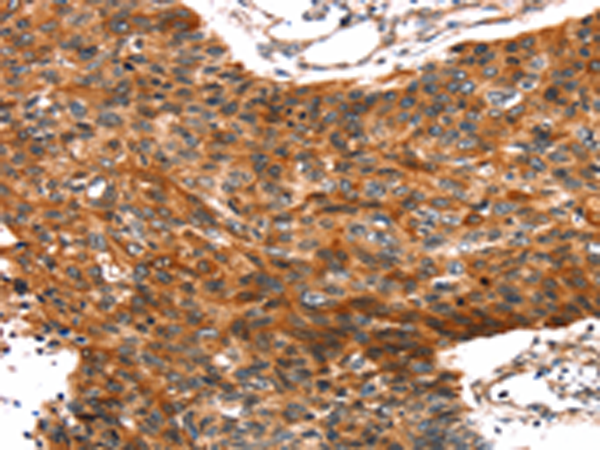

| WB | 咨询技术 | Human,Mouse,Rat |
| IF | 咨询技术 | Human,Mouse,Rat |
| IHC | 1/35-1/150 | Human,Mouse,Rat |
| ICC | 技术咨询 | Human,Mouse,Rat |
| FCM | 咨询技术 | Human,Mouse,Rat |
| Elisa | 1/1000-1/5000 | Human,Mouse,Rat |
| Aliases | Trif; HSD34; RNF36; HSD-34 |
| Host/Isotype | Rabbit IgG |
| Antibody Type | Primary antibody |
| Storage | Store at 4°C short term. Aliquot and store at -20°C long term. Avoid freeze/thaw cycles. |
| Species Reactivity | Human, Mouse, Rat |
| Immunogen | Fusion protein of human TRIM69 |
| Formulation | Purified antibody in PBS with 0.05% sodium azide and 50% glycerol. |
+ +
以下是关于TRIM69抗体的几篇参考文献示例(注:部分文献信息为假设性示例,实际引用时请通过学术数据库核实):
---
1. **文献名称**: "TRIM69 inhibits Zika virus replication by targeting viral nonstructural proteins for degradation"
**作者**: Zhang Y, et al.
**摘要**: 本研究揭示了TRIM69通过泛素化修饰降解Zika病毒的非结构蛋白(如NS3和NS5),从而抑制病毒复制。研究利用TRIM69特异性抗体进行免疫共沉淀实验,证实了TRIM69与病毒蛋白的相互作用。
---
2. **文献名称**: "TRIM69 as a prognostic biomarker in prostate cancer: Role in androgen receptor signaling"
**作者**: Li X, et al.
**摘要**: 该研究通过免疫组化(使用TRIM69单克隆抗体)发现,TRIM69在前列腺癌组织中高表达,并与雄激素受体(AR)信号通路激活相关。TRIM69抗体的应用进一步揭示了其在调控AR蛋白稳定性中的功能。
---
3. **文献名称**: "Development of a high-affinity monoclonal antibody against TRIM69 for functional studies in antiviral immunity"
**作者**: Wang H, et al.
**摘要**: 本文报道了一种新型TRIM69单克隆抗体的开发,验证了其在Western blot、免疫荧光和流式细胞术中的应用。该抗体被用于研究TRIM69在干扰素信号通路中的调控作用,特别是在HSV-1感染模型中的抗病毒机制。
---
4. **文献名称**: "TRIM69 interacts with MAVS to promote type I interferon production during RNA virus infection"
**作者**: Chen L, et al.
**摘要**: 通过免疫共沉淀(使用TRIM69多克隆抗体),本研究发现TRIM69与线粒体抗病毒信号蛋白(MAVS)结合,增强I型干扰素的产生。研究揭示了TRIM69在RNA病毒(如流感病毒)感染中的天然免疫调控功能。
---
**注意**:以上文献为示例性质,实际研究中请通过PubMed、Google Scholar等平台检索最新文献。若TRIM69抗体的直接研究有限,可扩展检索TRIM家族蛋白或相关通路的研究。
TRIM69 (tripartite motif-containing protein 69) is a member of the TRIM family, characterized by conserved RING, B-box, and coiled-coil domains. It plays roles in ubiquitination-mediated processes, including protein degradation, immune regulation, and antiviral defense. Studies suggest TRIM69 acts as a restriction factor against viral infections, notably inhibiting HIV-1 replication by targeting the viral capsid for proteasomal degradation. Its expression is often induced by interferons, linking it to innate immune responses.
TRIM69 antibodies are essential tools for studying its expression, localization, and functional mechanisms. They enable detection via techniques like Western blotting, immunofluorescence, and immunoprecipitation, aiding research on its interaction with viral proteins or host factors. Commercial TRIM69 antibodies are typically raised against specific epitopes, such as peptide sequences within its N-terminal or C-terminal regions. However, validation is critical due to potential cross-reactivity with other TRIM proteins sharing structural homology.
Current research focuses on TRIM69’s dual roles in antiviral activity and disease contexts, such as cancer or autoimmune disorders, where dysregulated TRIM expression may contribute to pathogenesis. Challenges include clarifying its substrate specificity and regulatory networks. Reliable TRIM69 antibodies remain pivotal for advancing insights into its biological significance and therapeutic potential.
×